Chennai Monuments
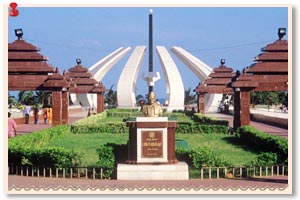 Chennai is the capital of Tamil Nadu. It boasts of a glorious past and has a rich cultural heritage. This is quite visible from the number of monuments in the city. Earlier known as Madras, the city has a plethora of monuments which significantly reveal the ancient history of the place. These monuments are a huge hit amongst the tourists and visitors to the state. The ancient city of Chennai is infact, enlivened with the splendor of the structures, which remind you of the bygone era. So, on your trip to Chennai don't forget to visit thee historical and architectural marvels.
Chennai is the capital of Tamil Nadu. It boasts of a glorious past and has a rich cultural heritage. This is quite visible from the number of monuments in the city. Earlier known as Madras, the city has a plethora of monuments which significantly reveal the ancient history of the place. These monuments are a huge hit amongst the tourists and visitors to the state. The ancient city of Chennai is infact, enlivened with the splendor of the structures, which remind you of the bygone era. So, on your trip to Chennai don't forget to visit thee historical and architectural marvels.Fort st. George
| Location: | Island Grounds |
| Built in: | 1640 |
| Built By: | The British |
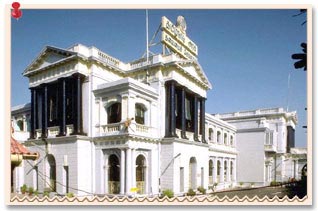 St. George Fort is located on the banks of Bay of Bengal. It was built by the British East India Company in 1640 AD. The fort is believed to be the first establishment of the British in India. It is a military architecture marvel, which was erected as a trading post and later evolved to be the origin of modern Indian Army. Situated in the coastal state of Tamil Nadu, this ancient monument is worth watching on your trip to Chennai. St. George Fort holds great historical importance and is looked after by the Archaeological Survey of India.
St. George Fort is located on the banks of Bay of Bengal. It was built by the British East India Company in 1640 AD. The fort is believed to be the first establishment of the British in India. It is a military architecture marvel, which was erected as a trading post and later evolved to be the origin of modern Indian Army. Situated in the coastal state of Tamil Nadu, this ancient monument is worth watching on your trip to Chennai. St. George Fort holds great historical importance and is looked after by the Archaeological Survey of India.Towards the end of the 17th century, the East India Company was established by the British. Their main aim behind this was trade and economic activities. After this, the company was looking for a permanent trading station. Their dream was realized when they acquired the land on which the fort stands today. The company built the fort on this land and expanded their activities. It served as a home away from home for the officials of the East India Company. This helped in the development of the city of Madras.
St. George Fort has a number of other worth watching monuments within its boundaries. St. Mary's Church, situated in the fort, is one of the oldest surviving churches built by the British in India. This beautiful building has stood the test of time and still holds the splendor of the yore. The glass windows, wall frescos, teak plaques still shine with their all time glory. Another fascinating structure here is the 150 ft tall Flagstaff, made entirely of teakwood. Though the original flagstaff is no more to be seen, its remains are still visible.
One of the most striking buildings here is the Fort St. George Museum. It houses the relics of the British personnel, who inhabited this fort. The construction of the building was completed ion 1795 and served as the Madras Bank. The long hallway upstairs once served the venue for public meetings as well as for entertainment. A light house was also built on top of the building in 1976. After Independence, the Archaeological Survey of India declared the fort as a protected monument.
The fort museum showcases a host of artifacts such as coins, medals, paintings, letters, etc, belonging to the colonial period. There is a 14.5 ft tall statue of Lord Cornwallis in front of the museum, which is an art masterpiece. It was brought to India from Britain through ship. It is carved with a scene depicting Tipu Sultan, his two sons and the East India Company officials. The importance of the fort cannot be undermined till date, as it still serves as an important base for the Indian Army.
Freemasons Hall
| Location: | Egmore, Chennai |
| Built In: | 1923 |
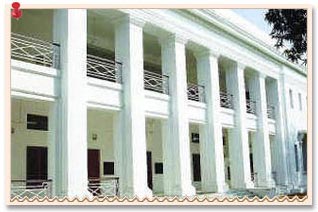 Freemasons Hall is situated in the Egmore area of Chennai. It is the living example of the cultural and traditional heritage of the people who inhabited the ancient city of Madras. The construction of this building was completed in the year 1923. Freemasons Hall was constructed by the East India Company, during the colonial rule. The purpose behind constructing such a building was to create military lodges, secured by the foreign powers. Freemasons Hall is one of the finest buildings of Tamil Nadu.
Freemasons Hall is situated in the Egmore area of Chennai. It is the living example of the cultural and traditional heritage of the people who inhabited the ancient city of Madras. The construction of this building was completed in the year 1923. Freemasons Hall was constructed by the East India Company, during the colonial rule. The purpose behind constructing such a building was to create military lodges, secured by the foreign powers. Freemasons Hall is one of the finest buildings of Tamil Nadu.The location of the structure is such that it can be easily reached from any corner of the city. Freemasons Hall is a double storey mansion and can accommodate around 200 people at a time. It has been designed with the help of Greek style of engineering. This is clearly visible from the mammoth pillars and the use of Italian tiles and marbles, which adorn the interiors of the Hall. The small Lodge room on the first floor is capable of accommodating 60 people at a time and is meant for holding Masonic meetings.
There is a Dinning Hall on the first floor which is approached by a winding staircase. This staircase is made up of Sholingar stones, with wrought iron and grill. The verandas are adorned with Italian tiles. The two lodge rooms are illuminated and ventilated with the help of huge windows, nearly 12 feet above the floor. The walls are decorated with Masonic emblems, which are formed by plaster and glided. Consequently, the Freemasons Hall is constructed keeping in mind all the modern day requirements and Indian climatic conditions.
Government Museum
| Location: | Pantheon Road, Egmore |
| Main Attraction: | Ancient artifacts and relics |
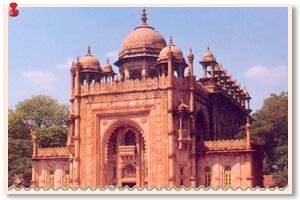 The Government Museum of Chennai is one of the most popular sightseeing pots in the city. It is deemed to be one of the oldest museums of India, as its inception dates back to the Colonial rule. There is a historical tale behind the origin of this Museum. In 1846 AD, the Madras Literary Society debated the proposal of establishing the museum. Finally, the proposal was approved by the Court of Directors of the East India Company in London. Chennai Government Museum has a sprawling complex and is sponsored by the State Government.
The Government Museum of Chennai is one of the most popular sightseeing pots in the city. It is deemed to be one of the oldest museums of India, as its inception dates back to the Colonial rule. There is a historical tale behind the origin of this Museum. In 1846 AD, the Madras Literary Society debated the proposal of establishing the museum. Finally, the proposal was approved by the Court of Directors of the East India Company in London. Chennai Government Museum has a sprawling complex and is sponsored by the State Government.There are six independent buildings in the Museum campus, which constitute 46 galleries. The Museum was formally inaugurated on December 5, 1896 by the Sir Arthur Elibank Havelock, the then Governor. He named it after the former Governor, Lord Connenmara. The museum was designed by H. Irvin, the consulting architect of the Government of Madras. The Government Museum has a splendid hall, marvelous reading room and striking Teak wood shelf and stands divided into a number of sections.
These sections include those on Geology, Archeology, Zoology, Anthropology, Numismatics, Botany and Sculpture. Also, there are four galleries in the museum. They comprise of the Hindu Sculpture Gallery, Bronze Gallery, Amravathi Gallery and National Art Gallery. Apart from this, the Government Museum also houses a Children's Museum, which is a special section dedicated exclusively to Children. The Children's Museum includes three sections, namely Civilization Gallery, Transportation Gallery and Kids Corner.
Kamaraj Memorial House
| Location: | T. Nagar |
| Inaugurated In: | 1978 |
| Dedicated To: | Shri Kamraj, Former Chief Minister |
Kamaraj Memorial House is built in the memory of the former Chief Minister of Tamil Nadu, Shri Kamaraj. He was an ideal for all the Indians, as he rose out of poverty and became the Chief Minster thrice. The Memorial House was inaugurated in 1978 by the then Chief Minister, M. G. Ramchandaran. The memorial is spread on the two floors of the building. It showcases the personal photographs and effects of Shri Kamaraj, which provide an insight into his life.
The ground floor has a bedroom which was once the personal den of this venerated bachelor. The room is adorned with plain furniture that symbolizes the plain and simple life Shri Kamaraj led. There is also a well stocked library in the house, occupied by the books like volumes of 'Lok Sabha Debates', '100 Modern Lives', 'Churchill' and 'Doctor Zhivago'. Shri Kamaraj had to discontinue his schooling, but it did not stop him from becoming a well read man. The Memorial House also exhibits a rare collection of his photographs.
The walls of the dinning hall are covered with black and white photographs of Kamaraj's life. The photographs provide a quick look at his childhood, youth upto his late life years. Some of the most intriguing pictures are thaose of his 1954 swearing-in as Chief Minister of Tamil Nadu, the first Kamaraj Ministry of 1954, the second of 1957 and the third of 1962. There are even pictures of him with eminent personalities, like Pt. Nehru, Sarojini Naidu, Rajendra Prasad, Lal Bahadur Shastri, Indira Gandhi, M.G Ramachandran, Martin Luther King, Queen Elizabeth, etc.
The second floor of the House also displays a number of his belongings, like luxuriant Felicitation Shawls, his simple attire, his suitcases, timepiece, pens and utensils. One of the prized possessions of this exhibition is the prison coat, worn by him while serving term in prison in the year 1942. The displayed personal effects of Kamaraj include his spectacles, a spool tape player and even a Gillette shaving set. Apart from this, there are also pictures showing the leader in different moods.
The ground floor has a bedroom which was once the personal den of this venerated bachelor. The room is adorned with plain furniture that symbolizes the plain and simple life Shri Kamaraj led. There is also a well stocked library in the house, occupied by the books like volumes of 'Lok Sabha Debates', '100 Modern Lives', 'Churchill' and 'Doctor Zhivago'. Shri Kamaraj had to discontinue his schooling, but it did not stop him from becoming a well read man. The Memorial House also exhibits a rare collection of his photographs.
The walls of the dinning hall are covered with black and white photographs of Kamaraj's life. The photographs provide a quick look at his childhood, youth upto his late life years. Some of the most intriguing pictures are thaose of his 1954 swearing-in as Chief Minister of Tamil Nadu, the first Kamaraj Ministry of 1954, the second of 1957 and the third of 1962. There are even pictures of him with eminent personalities, like Pt. Nehru, Sarojini Naidu, Rajendra Prasad, Lal Bahadur Shastri, Indira Gandhi, M.G Ramachandran, Martin Luther King, Queen Elizabeth, etc.
The second floor of the House also displays a number of his belongings, like luxuriant Felicitation Shawls, his simple attire, his suitcases, timepiece, pens and utensils. One of the prized possessions of this exhibition is the prison coat, worn by him while serving term in prison in the year 1942. The displayed personal effects of Kamaraj include his spectacles, a spool tape player and even a Gillette shaving set. Apart from this, there are also pictures showing the leader in different moods.
MGR Memorial
| Location: | T. Nagar |
| Dedicated To: | MGR Ramachandran |
| Inaugurated In: | 1990 |
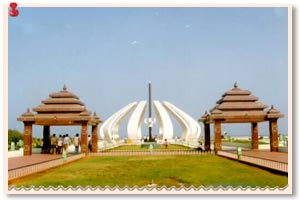 MGR Memorial is a yet another memorial in Chennai. It is dedicated to the former actor cum politician of Tamil Nadu, MGR Ramachandran. The monument is situated at T. Nagar and is easily accessible from all parts of the city. MGR Memorial was inaugurated by Mrs. Janaki MGR in 1990. It was the official residence of the politician for more than two decades. As soon as you enter the house, you can see a dark green colored car, which still has the number plate intact on it.
MGR Memorial is a yet another memorial in Chennai. It is dedicated to the former actor cum politician of Tamil Nadu, MGR Ramachandran. The monument is situated at T. Nagar and is easily accessible from all parts of the city. MGR Memorial was inaugurated by Mrs. Janaki MGR in 1990. It was the official residence of the politician for more than two decades. As soon as you enter the house, you can see a dark green colored car, which still has the number plate intact on it.The hummable music of the songs of his films, fill the environment with the memories of the yore. As you reach the reception, you will see the various shields presented to the actor. His office is located at the first floor, which is adorned with all his belongings and personal effects. The exhibits in the room includes swords, spears, heavy wooden clubs, his plate, tumbler, telephone instrument, his shirts, the medals won by him, television, the books read by him, camera, trolley & the cloth bandage that was tied on him when he was shot.
Apart from this, the room also holds memoirs like photographs taken from MGR's films, letters received by him, Dr.MGR's MLA identification card, his famous cap and dark glasses, pen, the 'Bharath Ratna' medal and the doctorate degree certificate. Taking into consideration the gallery of the films and the photos displayed, it is simply a treat for MGR's fan. The most astonishing feature of the memorial is that it does not have a single sponsor.
According to MGR's will, the memorial is maintained by the revenue generated from the market he owned at Alandur. From the day of its inception, thousands of his fan and visitors have thronged the place to experience the splendor of the beloved actor-cum-politician and remember him with affection. The entrance of MGR Memorial has been marked with a bronze statue of Ramachandran. The memorial is maintained by the MGR Memorial Charitable Trust and has free entry for all.
| Location: | University of Madras Campus |
| Built In: | 1873 |
| Designed By: | Robert Fellowes Chisholm |
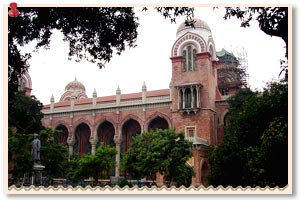 Senate House of Chennai is definitely a worth watching monument in Tamil Nadu. It is located at the campus of University of Madras, near the Marina Beach. It is truly an architectural marvel and was constructed under the supervision of one of the greatest architects of the 19th century, Robert Fellowes Chisholm. The foundation of this monument was laid in 1869 and was successfully completed by the year 1873. The Senate House was once the hallmark of the ancient city of Madras.
Senate House of Chennai is definitely a worth watching monument in Tamil Nadu. It is located at the campus of University of Madras, near the Marina Beach. It is truly an architectural marvel and was constructed under the supervision of one of the greatest architects of the 19th century, Robert Fellowes Chisholm. The foundation of this monument was laid in 1869 and was successfully completed by the year 1873. The Senate House was once the hallmark of the ancient city of Madras.Its structure is a creative and harmonious blend of Indo-Saracenic style, with Byzantine architectural features. The central room of Senate Hall is huge in measurement and is supported with six mammoth stone pillars on each side. The building is surrounded by four spearing towers, flanked by exquisite domes, painted in different colors. This adds to the magnanimity and splendor of the monument. Apart from this, there is an entrance towards the north, which leads to the convocation hall.
The entrance towards the south is linked with rooms on the southern wing. Besides, there are two entrances on east and west side of the Senate House. The front side of these entrances was marked with elegant porticos. At the corner of these porticos, there is a small domed size structure which adds up to the beauty of the arrangement. The Senate House had a great utility once, as it housed some of the university departments as well as the offices of the Vice-Chancellor and Registrar.
With time this magnificent structure has been withering away and losing its age old charm. Ignorance and the fury of the nature are responsible for its deteriorating condition. However, some effort have been made to reinstate is initial beauty with the help of renovation. But, in order to avoid any tampering with its original structure, the university is making earnest efforts. It has researched into the matter and has appealed to alumni, lovers of art, philanthropists, the public and private organizations to come forward to preserve the grand Senate House.
Thousand Lights Mosque
| Location: | Anna Salai Road |
| Built in: | Mid 1800 |
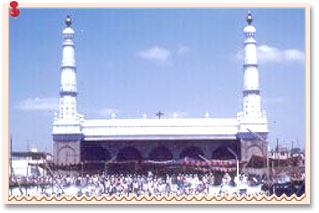 Thousand Lights Mosque is a well-known worship place for the Muslims in the Chennai city of Tamil Nadu. It is situated at the Anna Salai Road in the city. The mosque is popular for a number of reasons, such as its name, its architecture and its historical and religious importance. In early 19th century, the place where the mosque presently stands used to be the assembly place of the Shiite Muslims, during the month of Muharram. Later, the assembly hall was built, following which the mosque was constructed.
Thousand Lights Mosque is a well-known worship place for the Muslims in the Chennai city of Tamil Nadu. It is situated at the Anna Salai Road in the city. The mosque is popular for a number of reasons, such as its name, its architecture and its historical and religious importance. In early 19th century, the place where the mosque presently stands used to be the assembly place of the Shiite Muslims, during the month of Muharram. Later, the assembly hall was built, following which the mosque was constructed.The total area of the land, which was donated by Nawab Wallajah, occupied by the Thousand Lights Mosque is 3 acres. There is an interesting story behind the name of the mosque. It is said that 1000 lamps needed to be lit in order to illuminate the assembly hall. From this, it derived its name, Thousands Lights Mosque. However, there are others, who are of the belief that the lights were provided by the Indian National Congress to mark their first visit to the city of Madras. The mosque is a medieval architectural style building.
It has an exhilarating structure, with multi domes and spearing minarets. The average height of the minarets is around 64 feet above the ground. Besides, the mosque is adorned with the quotes from the holy book of Muslims, the Quran. There is a main hall at the ground floor to offer prayers for men, while there is a separate room for women. There are two rooms on the second floor which are known as Bargah and represent the sanctuary. Thousand Lights Mosque holds great importance for the Shiite Muslims and is a pilgrimage site for them.
Valluvar Kottam
| Built In: | 1976 |
| Dedicated To: | Saint Thiruvalluvar |
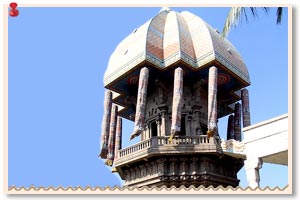 Valluvar Kottam is a monument built to pay homage to Tamil Poet Saint Thiruvalluvar. The site where it is situated once housed an unused lake. The monument is in the shape of a temple chariot and contains a lively and splendid statue of the poet. The temple chariot is a replica of the one at Thiruvar. Thiruvalluvar's significant contribution to Tamil literature is in the form of Thirukkural. As a tribute, 133 verses from the same literary work have been inscribed at the base of the chariot.
Valluvar Kottam is a monument built to pay homage to Tamil Poet Saint Thiruvalluvar. The site where it is situated once housed an unused lake. The monument is in the shape of a temple chariot and contains a lively and splendid statue of the poet. The temple chariot is a replica of the one at Thiruvar. Thiruvalluvar's significant contribution to Tamil literature is in the form of Thirukkural. As a tribute, 133 verses from the same literary work have been inscribed at the base of the chariot.In order to achieve this task, 3000 blocks of stones were required at time of the construction. Valluvar Kottam is the only one of its kind monument in Tamil Nadu. Apart from this, there is an auditorium that can accommodate upto 4000 people at a time. The most fascinating feature is that all the verses from the epic Thirukkural are inscribed on the granite pillars, surrounding the auditorium.
No comments:
Post a Comment